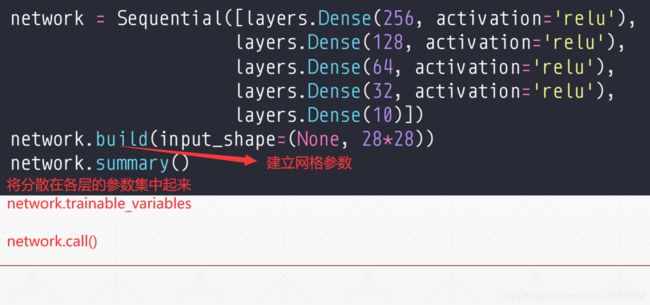文章目录
-
-
- 1.keras.Sequential
- 2.Layer/Model
- 3.自定义层
- 4.自定义网络
- 5.自定义网络实战-手写数字识别

1.keras.Sequential


2.Layer/Model

3.自定义层
class MyDense(layers.Layer):
def __init__(self,inp_dim,outp_dim):
super(MyDense,self).__init__()
self.kernel = self.add_variable('w',[inp_dim,outp_dim])
self.bias = self.add_variable('b',[outp_dim])
def call(self,inputs,training = None):
out = inputs @ self.kernel + self.bias
return out
4.自定义网络
class MyModel(keras.Model):
def __init__(self):
super(MyModel,self).__init__()
self.fc1 = MyDense(28*28,256)
self.fc2 = MyDense(256,128)
self.fc3 = MyDense(128,64)
self.fc4 = MyDense(64,32)
self.fc5 = MyDense(32,10)
def call(self,inputs,training = None):
x = self.fc1(inputs)
x = tf.nn.relu(x)
x = self.fc2(x)
x = tf.nn.relu(x)
x = self.fc3(x)
x = tf.nn.relu(x)
x = self.fc4(x)
x = tf.nn.relu(x)
x = self.fc5(x)
return x
5.自定义网络实战-手写数字识别
import os
os.environ['TF_CPP_MIN_LOG_LEVEL'] = '2'
import tensorflow as tf
from tensorflow.keras import datasets, layers, optimizers, Sequential, metrics
from tensorflow import keras
def preprocess(x, y):
"""
x is a simple image, not a batch
"""
x = tf.cast(x, dtype=tf.float32) / 255.
x = tf.reshape(x, [28 * 28])
y = tf.cast(y, dtype=tf.int32)
y = tf.one_hot(y, depth=10)
return x, y
batchsz = 128
(x, y), (x_val, y_val) = datasets.mnist.load_data()
print('datasets:', x.shape, y.shape, x.min(), x.max())
db = tf.data.Dataset.from_tensor_slices((x, y))
db = db.map(preprocess).shuffle(60000).batch(batchsz)
ds_val = tf.data.Dataset.from_tensor_slices((x_val, y_val))
ds_val = ds_val.map(preprocess).batch(batchsz)
sample = next(iter(db))
print(sample[0].shape, sample[1].shape)
network = Sequential([layers.Dense(256, activation='relu'),
layers.Dense(128, activation='relu'),
layers.Dense(64, activation='relu'),
layers.Dense(32, activation='relu'),
layers.Dense(10)])
network.build(input_shape=(None, 28 * 28))
network.summary()
class MyDense(layers.Layer):
def __init__(self, inp_dim, outp_dim):
super(MyDense, self).__init__()
self.kernel = self.add_variable('w', [inp_dim, outp_dim])
self.bias = self.add_variable('b', [outp_dim])
def call(self, inputs, training=None):
out = inputs @ self.kernel + self.bias
return out
class MyModel(keras.Model):
def __init__(self):
super(MyModel, self).__init__()
self.fc1 = MyDense(28 * 28, 256)
self.fc2 = MyDense(256, 128)
self.fc3 = MyDense(128, 64)
self.fc4 = MyDense(64, 32)
self.fc5 = MyDense(32, 10)
def call(self, inputs, training=None):
x = self.fc1(inputs)
x = tf.nn.relu(x)
x = self.fc2(x)
x = tf.nn.relu(x)
x = self.fc3(x)
x = tf.nn.relu(x)
x = self.fc4(x)
x = tf.nn.relu(x)
x = self.fc5(x)
return x
network = MyModel()
network.compile(optimizer=optimizers.Adam(lr=0.01),
loss=tf.losses.CategoricalCrossentropy(from_logits=True),
metrics=['accuracy']
)
network.fit(db, epochs=5, validation_data=ds_val,
validation_freq=2)
network.evaluate(ds_val)
sample = next(iter(ds_val))
x = sample[0]
y = sample[1]
pred = network.predict(x)
y = tf.argmax(y, axis=1)
pred = tf.argmax(pred, axis=1)
print(pred)
print(y)



